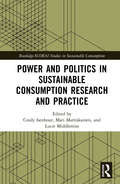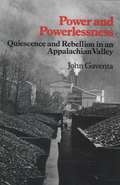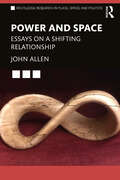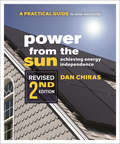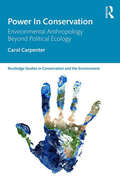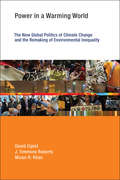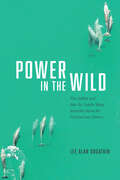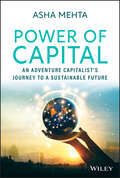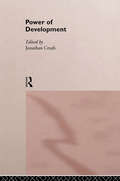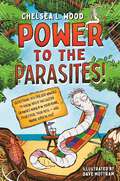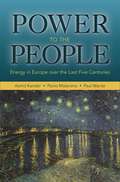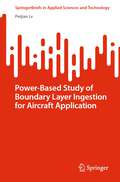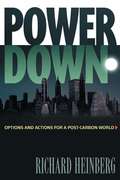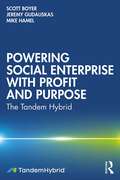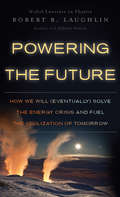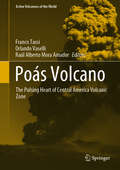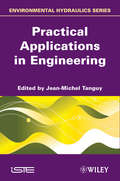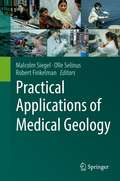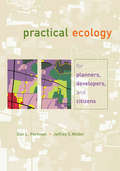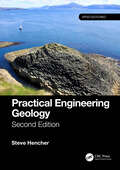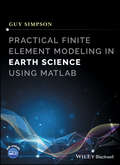- Table View
- List View
Power and Politics in Sustainable Consumption Research and Practice (Routledge-SCORAI Studies in Sustainable Consumption)
by Cindy Isenhour Lucie Middlemiss Mari MartiskainenWith growing awareness of environmental deterioration, atmospheric pollution and resource depletion, the last several decades have brought increased attention and scrutiny to global consumption levels. However, there are significant and well documented limitations associated with current efforts to encourage more sustainable consumption patterns, ranging from informational and time constraints to the highly individualizing effect of market-based participation. This volume, featuring essays solicited from experts engaged in sustainable consumption research from around the world, presents empirical and theoretical illustrations of the various means through which politics and power influence (un)sustainable consumption practices, policies and perspectives. With chapters on compelling topics including collective action, behaviour-change and the transition movement, the authors discuss why current efforts have largely failed to meet environmental targets and explore promising directions for research, policy and practice. Featuring contributions that will help the reader open up politics and power in ways that are accessible and productive and bridge the gaps with current approaches to sustainable consumption, this book will be of great interest to students and scholars of sustainable consumption and the politics of sustainability.
Power and Powerlessness: Quiescence and Rebellion in an Appalachian Valley
by John GaventaThis book establishes that power works to develop and maintain the quiescence of the powerless; rebellion, as a corollary, may emerge as power relationships are altered and together, patterns of power and powerlessness can keep issues from arising, grievances from being voiced, and interests from being recognized.
Power and Space: Essays on a Shifting Relationship (Routledge Research in Place, Space and Politics)
by John AllenPower and Space sets out the inherently spatial nature of power today and seeks to change the conversation around how power exercises us in the contemporary moment.The essays brought together in this book are a response to the fact that conventional descriptions of power and its ordered geographies no longer chime with our lived experience. Spatiality matters to the workings of power nowadays, and this book sheds light on what it is that we face when power is exercised through more subtle, spatially nuanced arrangements. It is divided into three parts, each representing a different kind of engagement with power’s relationship to space, from the spatial shifts in the way power is exercised through to its assemblage-like entanglements and, in turn, its progressive topological character. Throughout the book, a wide range of social, political and economic examples are drawn upon to illustrate a more provisional sense of power, ranging, for instance, from the seductive logic of privatized public spaces to the attempt by a data analytics company to manipulate political behaviour, through to the offshore spaces invented by rising financial elites to challenge the established banking order.Illustrating the new-found abilities of the powerful to make their presence felt, this book provides an accessible account of the practical workings of power in the present day. It will be invaluable to students and academics in human geography and urban studies as well as politics, sociology and cultural studies.
Power from the Sun: A Practical Guide to Solar Electricity (Revised Second Edition)
by Dan ChirasWritten for the layman, this is the fully revised and updated guide for individuals and businesses interested in generating their own electricity using the Sun. Practical and accessible, it provides a basic understanding of electricity, wiring, and solar energy, and guides the reader through site assessment and determining the type of system needed, providing a solid understanding of grid-tied and off-grid systems, along with important guidelines on installation.
Power in Conservation: Environmental Anthropology Beyond Political Ecology (Routledge Studies in Conservation and the Environment)
by Carol CarpenterThis book examines theories and ethnographies related to the anthropology of power in conservation. Conservation thought and practice is power laden—conservation thought is powerfully shaped by the history of ideas of nature and its relation to people, and conservation interventions govern and affect peoples and ecologies. This book argues that being able to think deeply, particularly about power, improves conservation policy-making and practice. Political ecology is by far the most well-known and well-published approach to thinking about power in conservation. This book analyzes the relatively neglected but robust anthropology of conservation literature on politics and power outside political ecology, especially literature rooted in Foucault. It is intended to make four of Foucault’s concepts of power accessible, concepts that are most used in the anthropology of conservation: the power of discourses, discipline and governmentality, subject formation, and neoliberal governmentality. The important ethnographic literature that these concepts have stimulated is also examined. Together, theory and ethnography underpin our emerging understanding of a new, Anthropocene-shaped world. This book will be of great interest to students and scholars of conservation, environmental anthropology, and political ecology, as well as conservation practitioners and policy-makers.
Power in a Warming World: The New Global Politics of Climate Change and the Remaking of Environmental Inequality (Earth System Governance)
by J. Timmons Roberts Mizan R. Khan David CipletAn examination of shifting global power dynamics in climate change politics, and how this affects our ability to achieve equitable and sustainable climate outcomes.After nearly a quarter century of international negotiations on climate change, we stand at a crossroads. A new set of agreements is likely to fail to prevent the global climate's destabilization. Islands and coastlines face inundation, and widespread drought, flooding, and famine are expected to worsen in the poorest and most vulnerable countries. How did we arrive at an entirely inequitable and scientifically inadequate international response to climate change? In Power in a Warming World, David Ciplet, J. Timmons Roberts, and Mizan Khan, bring decades of combined experience as negotiators, researchers, and activists to bear on this urgent question. Combining rich empirical description with a political economic view of power relations, they document the struggles of states and social groups most vulnerable to a changing climate and describe the emergence of new political coalitions that take climate politics beyond a simple North-South divide. They offer six future scenarios in which power relations continue to shift as the world warms. A focus on incremental market-based reform, they argue, has proven insufficient for challenging the enduring power of fossil fuel interests, and will continue to be inadequate without a bolder, more inclusive and aggressive response.
Power in the Wild: The Subtle and Not-So-Subtle Ways Animals Strive for Control over Others
by Lee Alan DugatkinFrom the shell wars of hermit crabs to little blue penguins spying on potential rivals, power struggles in the animal kingdom are as diverse as they are fascinating, and this book illuminates their surprising range and connections. The quest for power in animals is so much richer, so much more nuanced than who wins what knock-down, drag-out fight. Indeed, power struggles among animals often look more like an opera than a boxing match. Tracing the path to power for over thirty different species on six continents, writer and behavioral ecologist Lee Alan Dugatkin takes us on a journey around the globe, shepherded by leading researchers who have discovered that in everything from hyenas to dolphins, bonobos to field mice, cichlid fish to cuttlefish, copperhead snakes to ravens, and meerkats to mongooses, power revolves around spying, deception, manipulation, forming and breaking up alliances, complex assessments of potential opponents, building social networks, and more. Power pervades every aspect of the social life of animals: what they eat, where they eat, where they live, whom they mate with, how many offspring they produce, whom they join forces with, and whom they work to depose. In some species, power can even change an animal’s sex. Nor are humans invulnerable to this magnificently intricate melodrama: Dugatkin’s tales of the researchers studying power in animals are full of unexpected pitfalls, twists and turns, serendipity, and the pure joy of scientific discovery.
Power of Capital: An Adventure Capitalist's Journey to a Sustainable Future
by Asha MehtaExplore and understand how investment capital is transforming the world&’s most critical emerging markets In Power of Capital: An Adventure Capitalist&’s Journey to a Sustainable Future, distinguished author and Chief Investment Officer at Global Delta Capital, Asha Mehta, shares a simultaneously daring and heartening exploration of rapidly evolving emerging markets. Delivering equal doses of business discussion and geopolitical insight, the author examines the changes gripping the globe and why the average person—and investor—should care. The book provides an on-the-ground perspective informed by the author&’s personal experiences and visits to far-flung regions of the world. It also shares incisive commentary on issues crucial to continuing global economic growth, including terrorism and instability, corruption and autocracy, and sustainable investing. Power of Capital offers: Illuminating insights of China&’s new role as a global economic powerhouse Pioneering perspectives of how sustainable investing delivers both alpha and impact Explorations of how globalization and technology disrupt companies and sectors In-depth discussions of data&’s new and central role as the primary store and creator of value in the modern economy The case for women as the greatest emerging market in the world A page-turning read from a singular and worldly generational leader, Power of Capital: An Adventure Capitalist&’s Journey to a Sustainable Future offers a unique and thought-provoking trip to the globe&’s most fascinating emerging markets.
Power of Development
by Jonathan CrushPost-colonial, post-modern and feminist critiques have challenged the ways we theorise and practice development. Development is not just the conclusion of economic logic; its histories reveal a legacy of contested power, illuminating the contemporary battlefields of knowledge. These essays explore the language of development, its rhetoric and meaning within different political and institutional contexts. The contested ideas behind world development are explained, with illustrative material, sensitive to place and time, chiefly drawn from Asia, Africa and Latin America. This book examines the power of development to imagine new worlds and to constantly reinvent itself as the solution to problems of national and global disorder.
Power to the Parasites!
by Chelsea L. WoodPower to the Parasites! lets you in on a secret: Parasites are all around you, all the time, quietly running the world. You might think of them as slimy, disgusting freeloaders – tapeworms and roundworms and ticks and lice, too small to be important and too selfish to be valued. But by the end of this book, you’ll realize that sometimes parasites are the good guys.Learn where you’re most likely to find parasites in your own food (heads up, you might not want to eat any uncooked fish right before reading this book), and how parasitic infection changes the behavior of many organisms—including human beings. Parasites might be weird and mysterious, but the better we understand them, the less we have to fear about them. In fact, many parasites are in big trouble. With climate change threatening parasites around the world, there’s no better time than right now to learn about these often-unseen creatures living among us.
Power to the People: Energy in Europe over the Last Five Centuries (The Princeton Economic History of the Western World #46)
by Paul Warde Astrid Kander Paolo MalanimaPower to the People examines the varied but interconnected relationships between energy consumption and economic development in Europe over the last five centuries. It describes how the traditional energy economy of medieval and early modern Europe was marked by stable or falling per capita energy consumption, and how the First Industrial Revolution in the eighteenth century--fueled by coal and steam engines--redrew the economic, social, and geopolitical map of Europe and the world. The Second Industrial Revolution continued this energy expansion and social transformation through the use of oil and electricity, but after 1970 Europe entered a new stage in which energy consumption has stabilized. This book challenges the view that the outsourcing of heavy industry overseas is the cause, arguing that a Third Industrial Revolution driven by new information and communication technologies has played a major stabilizing role. Power to the People offers new perspectives on the challenges posed today by climate change and peak oil, demonstrating that although the path of modern economic development has vastly increased our energy use, it has not been a story of ever-rising and continuous consumption. The book sheds light on the often lengthy and complex changes needed for new energy systems to emerge, the role of energy resources in economic growth, and the importance of energy efficiency in promoting growth and reducing future energy demand.
Power-Based Study of Boundary Layer Ingestion for Aircraft Application (SpringerBriefs in Applied Sciences and Technology)
by Peijian LvThis book presents research on Boundary Layer Ingestion (BLI). BLI is an aircraft-engine integration technique that aims at integrating the aircraft and the propulsion system such that the overall aircraft fuel consumption can be reduced. In this research, theoretical analysis suggests that the minimization of total power consumption should be used as a design criterion for aircraft utilizing BLI rather than focusing on the minimization of drag. Numerical simulations are performed, and the simulation results are processed using the PBM to support the theoretical analysis. Furthermore, an experimental study is carried out with a focus on the power conversion processes involved for a propulsor operating in the wake. Stereoscopic PIV is employed in order to visualize the flow and understand the physics. The so-called Power-based Method is used to quantify the power conversion mechanisms. The results prove that the dominant mechanism responsible for the efficiency enhancement is due to the utilization of body wake energy by the wake ingesting propeller. In short, the importance of wake energy flow rate in understanding the BLI phenomenon is highlighted. This book will be useful for researchers in the field of aircraft propulsion, aircraft aerodynamics, and airframe propulsion integration.
Powerdown
by Richard HeinbergIf the US continues with its current policies, the next decades will be marked by war, economic collapse, and environmental catastrophe. Resource depletion and population pressures are about to catch up with us, and no one is prepared. The political elites, especially in the US, are incapable of dealing with the situation and have in mind a punishing game of "Last One Standing."The alternative is "Powerdown," a strategy that will require tremendous effort and economic sacrifice in order to reduce per-capita resource usage in wealthy countries, develop alternative energy sources, distribute resources more equitably, and reduce the human population humanely but systematically over time. While civil society organizations push for a mild version of this, the vast majority of the world's people are in the dark, not understanding the challenges ahead, nor the options realistically available.Powerdown speaks frankly to these dilemmas. Avoiding cynicism and despair, it begins with an overview of the likely impacts of oil and natural gas depletion and then outlines four options for industrial societies during the next decades:Last One Standing: the path of competition for remaining resources;Powerdown: the path of cooperation, conservation and sharing;Waiting for a Magic Elixir: wishful thinking, false hopes, and denial;Building Lifeboats: the path of community solidarity and preservation.Finally, the book explores how three important groups within global society--the power elites, the opposition to the elites (the antiwar and antiglobalization movements, et al: the "Other Superpower"), and ordinary people--are likely to respond to these four options. Timely, accessible and eloquent, Powerdown is crucial reading for our times.Richard Heinberg is an award-winning author of five previous books, including The Party's Over: Oil, War and the Fate of Industrial Societies. A member of the Core Faculty of New College of California, he lives in Santa Rosa, California.
Powerful Earthquakes
by Greg RozaLearn more about why earthquakes happen, history of some major earthquakes, and what you can do to prepare.
Powering Social Enterprise with Profit and Purpose: The Tandem Hybrid
by Scott Boyer Jeremy Gudauskas Mike HamelTrail-blazing social entrepreneurs are tackling the world’s most pressing problems that government, business, or charity have failed to solve. They are creating businesses with a primary mission of social change. Scott Boyer is one such social entrepreneur. This 28-year veteran of Big Pharma left a six-figure salary to start OWP Pharmaceuticals and the ROW Foundation. This commercial business and non-profit organization exist in a symbiotic relationship we call a "tandem hybrid social enterprise." This model combines a multimillion dollar business with a foundation that’s on track to become the largest funder of projects serving people with epilepsy and associated psychiatric disorders in the world. The tandem hybrid incorporates the principles learned by Scott and others for building a truly unique social enterprise from the ground up; one that is: Driven by a compelling social mission Financed by commercial success Structured to retain control Scalable and sustainable for the long haul Powering Social Enterprises With Profit And Purpose offers a detailed blueprint that has proven commercially and philanthropically successful and that can be replicated in most business sectors.
Powering Social Enterprise with Profit and Purpose: The Tandem Hybrid
by Scott Boyer Jeremy Gudauskas Mike HamelTrail-blazing social entrepreneurs are tackling the world’s most pressing problems that government, business, or charity have failed to solve. They are creating businesses with a primary mission of social change. Scott Boyer is one such social entrepreneur. This 28-year veteran of Big Pharma left a six-figure salary to start OWP Pharmaceuticals and the ROW Foundation. This commercial business and non-profit organization exist in a symbiotic relationship we call a "tandem hybrid social enterprise." This model combines a multimillion dollar business with a foundation that’s on track to become the largest funder of projects serving people with epilepsy and associated psychiatric disorders in the world.The tandem hybrid incorporates the principles learned by Scott and others for building a truly unique social enterprise from the ground up; one that is: Driven by a compelling social mission Financed by commercial success Structured to retain control Scalable and sustainable for the long haul Powering Social Enterprises With Profit And Purpose offers a detailed blueprint that has proven commercially and philanthropically successful and that can be replicated in most business sectors.
Powering the Future: How We Will (Eventually) Solve the Energy Crisis and Fuel the Civilization of Tomorrow
by Robert B. LaughlinLaughlin (physics, Stanford U. and Nobel Laureate) offers a readable case for where energy will come from when the world's oil is gone. He considers the economic, ecological, and geopolitical implications of a variety of probable alternatives in a somewhat comforting upbeat tone tempered with a good amount of common sense. Some of the options he sees: solar and wind, geothermal, biofuels (such as animal waste, vegetable matter), and nuclear power. Annotation ©2011 Book News, Inc. , Portland, OR (booknews. com)
Poás Volcano: The Pulsing Heart Of Central America Volcanic Zone (Active Volcanoes of the World)
by Franco Tassi Orlando Vaselli Raúl Alberto Mora AmadorThis book provides a comprehensive description of the volcanological, petrological and geochemical features of the Poás Volcano (Costa Rica), one of the most active volcanic systems in Central America and part of the Central America Volcanic Arc (CAVA). Poás Volcano hosts a unique sulfur lake, which actually is one of the world's most acidic lakes, and has experienced molten sulfur eruptions. Past investigations, current monitoring activities and planned programs of investigation into lessening of the volcanic hazard are reported here. Specific sections of the monograph will be devoted to the impact of this volcano on the social, agricultural and industrial activities in the area. Legends and popular traditions related to this volcano will be described in the last chapter to round up a complete scientific review on this unique volcanic system.
Practical Applications in Engineering
by Jean-Michel TanguyThis series of five volumes proposes an integrated description of physical processes modeling used by scientific disciplines from meteorology to coastal morphodynamics. Volume 1 describes the physical processes and identifies the main measurement devices used to measure the main parameters that are indispensable to implement all these simulation tools. Volume 2 presents the different theories in an integrated approach: mathematical models as well as conceptual models, used by all disciplines to represent these processes. Volume 3 identifies the main numerical methods used in all these scientific fields to translate mathematical models into numerical tools. Volume 4 is composed of a series of case studies, dedicated to practical applications of these tools in engineering problems. To complete this presentation, volume 5 identifies and describes the modeling software in each discipline.
Practical Applications of Medical Geology
by Olle Selinus Robert Finkelman Malcolm SiegelThis edited volume provides a framework for integrating methods and information drawn from geological and medical sciences and provides case studies in medical geology to illustrate the usefulness of this framework for crafting environmental and public health policies related to natural materials. The relevance of medical geology research to policy decisions is a topic rarely discussed, and this volume attempts to be a unique source for researchers and policy makers in the field of medical geology in addressing this gap in practical medical geology applications. The book's four sections establish this framework in detail using risk assessment, case studies, data analyses and specific medical geology techniques. Following an introduction to medical geology in the context of risk assessment and risk management, the second section discusses specific methods used in medical geology in the categories of geoscience, biomedicine, and data sources. The third section discusses the medical geology of natural materials, energy use, and environmental and workplace impacts. This section includes specific case studies in medical geology, and describes how the methods and data from the previous section are used in a medical geology analysis. The fourth section includes a guide to the medical geology literature and provides some examples of medical geology programs in Asia and Africa.
Practical Aspects of Computational Chemistry I: An Overview of the Last Two Decades and Current Trends
by Jerzy Leszczynski Manoj K. K. ShuklaPractical Aspects of Computational Chemistry I: An Overview of the Last Two Decades and Current Trends gathers the advances made within the last 20 years by well-known experts in the area of theoretical and computational chemistry and physics. The title itself reflects the celebration of the twentieth anniversary of the “Conference on Current Trends in Computational Chemistry (CCTCC)” to which all authors have participated and contributed to its success. This volume poses (and answers) important questions of interest to the computational chemistry community and beyond. What is the historical background of the “Structural Chemistry”? Is there any way to avoid the problem of intruder state in the multi-reference formulation? What is the recent progress on multi-reference coupled cluster theory? Starting with a historical account of structural chemistry, the book focuses on the recent advances made in promising theories such as many body Brillouin-Wigner theory, multireference state-specific coupled cluster theory, relativistic effect in chemistry, linear and nonlinear optical properties of molecules, solution to Kohn-Sham problem, electronic structure of solid state materials, development of model core potential, quantum Monte Carlo method, nano and molecular electronics, dynamics of photodimerization and excited states, intermolecular interactions, hydrogen bonding and non-hydrogen bonding interactions, conformational flexibility, metal cations in zeolite catalyst and interaction of nucleic acid bases with minerals. Practical Aspects of Computational Chemistry I: An Overview of the Last Two Decades and Current Trends is aimed at theoretical and computational chemists, physical chemists, materials scientists, and particularly those who are eager to apply computational chemistry methods to problem of chemical and physical importance. This book will provide valuable information to undergraduate, graduate, and PhD students as well as to established researchers.
Practical Aspects of Computational Chemistry II
by Jerzy Leszczynski Manoj ShuklaPractical Aspects of Computational Chemistry II: An Overview of the Last Two Decades and Current Trends gathers the discussion of advances made within the last 20 years by well-known experts in the area of theoretical and computational chemistry and physics. The title reflects the celebration of the twentieth anniversary of the "Conference on Current Trends in Computational Chemistry (CCTCC)" to success of which all authors contributed. Starting with the recent development of modeling of solvation effect using the Polarizable Continuum Model (PCM) at the Coupled-Cluster level and the effects of extreme pressure on the molecular properties within the PCM framework, this volume focuses on the association/dissociation of ion pairs in binary solvent mixtures, application of graph theory to determine the all possible structures and temperature-dependent distribution of water cluster, generalized-ensemble algorithms for the complex molecular simulation, QM/MD based investigation of formation of different nanostructures under nonequilibrium conditions, quantum mechanical study of chemical reactivity of carbon nanotube, covalent functionalization of single walled-carbon nanotube, designing of functional materials, importance of long-range dispersion interaction to study nanomaterials, recent advances in QSPR/QSAR analysis of nitrocompounds, prediction of physico-chemical properties of energetic materials, electronic structure and properties of 3d transition metal dimers, the s-bond activation reactions by transition metal complexes, theoretical modeling of environmental mercury depletion reaction, organolithium chemistry and computational modeling of low-energy electron induced DNA damage. Practical Aspects of Computational Chemistry II: An Overview of the Last Two Decades and Current Trends is aimed at theoretical and computational chemists, physical chemists, materials scientists, and particularly those who are eager to apply computational chemistry methods to problems of chemical and physical importance. This book provides valuable information to undergraduate, graduate, and PhD students as well as to established researchers. Practical Aspects of Computational Chemistry II: An Overview of the Last Two Decades and Current Trends is aimed at theoretical and computational chemists, physical chemists, materials scientists, and particularly those who are eager to apply computational chemistry methods to problems of chemical and physical importance. This book provides valuable information to undergraduate, graduate, and PhD students as well as to established researchers.
Practical Ecology for Planners, Developers, and Citizens
by Dan L. Perlman Jeffrey MilderPractical Ecology for Planners, Developers, and Citizens introduces and explains key ecological concepts for planners, landscape architects, developers, and others involved in planning and building human habitats. The book is tailored to meet the needs of busy land use professionals and citizens seeking a concise yet thorough overview of ecology and its applications. It offers clear guidelines and a wealth of information on how we can protect species and ecosystems while at the same creating healthy, sustainable human communities. Throughout the book, the authors make ecological concepts accessible to readers with little or no scientific background. They present key ideas and information in simple and pragmatic terms, and provide numerous graphics to help explain important concepts. They also offer exercises for the reader to practice ecologically-based planning and design, along with a list of resources for practical information on ecology and conservation. Practical Ecology for Planners, Developers, and Citizens will raise the level of ecological understanding among land use professionals and citizens, and is an invaluable new resource for anyone concerned with human land use and its environmental impacts.
Practical Engineering Geology (Applied Geotechnics)
by Steve HencherPractical Engineering Geology provides an introduction to the way projects are managed, designed and constructed, and how the engineering geologist can contribute to cost- effective and safe project achievement. The need for a holistic view of geological materials, from soil to rock, and of geological history is emphasised. Chapters address key aspects of• Geology for engineering and ground modelling• Site investigation and testing of geological materials• Geotechnical parameters• Design of slopes, tunnels, foundations, and other engineering structures• Identifying hazards• Avoiding unexpected ground conditionsThis second edition includes a new chapter on environmental issues covering hydrogeology, considerations of climate change, earthquakes, and more. All chapters have been updated, with extensively revised figures throughout and several new case studies of unexpected ground conditions. The book will support practising engineering geologists and geotechnical engineers, as well as MSc level students of engineering geology and other geotechnical subjects.
Practical Finite Element Modeling in Earth Science using Matlab
by Guy SimpsonMathematical models have become a crucial way for the Earth scientist to understand and predict how our planet functions and evolves through time and space. The finite element method (FEM) is a remarkably flexible and powerful tool with enormous potential in the Earth Sciences. This pragmatic guide explores how a variety of different Earth science problems can be translated and solved with FEM, assuming only basic programming experience. This book begins with a general introduction to numerical modeling and includes multiple sample Matlab codes to illustrate how FEM is implemented in practice. Textboxes have been included to provide additional detail, such as specialized Matlab usage or advanced topics. Covering all the key aspects, this is essential reading for those looking to master the technique, as well as those simply seeking to increase their basic level of understanding and appreciation of FEM.
